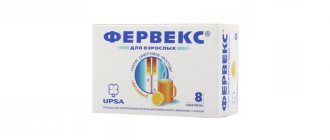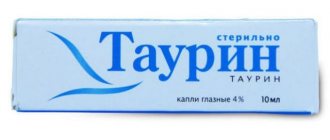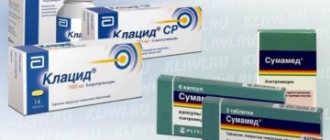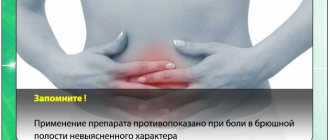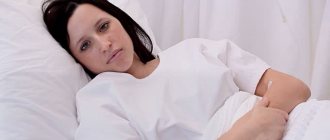Bicillin-5 powder is intended for diluting the suspension. Indications for use are: infectious and inflammatory diseases, syphilis, rheumatism. The powder is also prescribed for acute tonsillitis or wound infection.
Registration number:
LS-002273
Trade name: Bicillin-5
International nonproprietary or group name: benzathine benzylpenicillin + benzylpenicillin procaine
Dosage form: powder for the preparation of suspension for intramuscular administration
Release form and composition
Bicillin-5 is produced in the form of a powder for the preparation of a suspension for intramuscular (i.m.) administration: a powder prone to clumping, white with a yellow tint or white, after dilution forms a homogeneous, stable, milky suspension (10 ml in a bottle, in cardboard pack of 1, 5, 10 or 50 bottles).
Active ingredients contained in 1 bottle:
- benzylpenicillin novocaine salt (benzylpenicillin procaine) – 300 thousand units;
- benzathine benzylpenicillin – 1.2 million units.
Characteristic
Bicillin-1 is a white, odorless or almost odorless powder that forms a stable suspension when water is added.
Bicillin-3 is a white or white powder with a slightly yellowish tint, which forms a stable suspension when water is added.
Bicillin-5 is a white, odorless powder with a bitter taste, which forms a homogeneous suspension of milky turbidity when adding water, saline or 0.25–0.5% novocaine solution. With prolonged contact with water or other solutions, the physical and colloidal properties of the drug change (the suspension becomes uneven and difficult to flow through the syringe needle).
Pharmacological properties
Pharmacodynamics
Bicillin-5 is a bactericidal antibiotic containing two long-acting benzylpenicillin salts. Prevents the synthesis of the cell wall of a pathogenic microbe. Shows activity against the following microorganisms:
- gram-negative: Neisseria meningitidis, Neisseria gonorrhoeae, Treponema spp.;
- gram-positive: Actinomyces israelii, Streptococcus spp. (including Streptococcus pneumoniae), Staphylococcus spp. (non-penicillinase-forming), Clostridium spp., Corynebacterium diphtheriae, Bacillus anthracis, anaerobic spore-forming rods.
Strains of Staphylococcus spp. that produce penicillinase are resistant to the drug.
Pharmacokinetics
Bicillin-5 has a prolonged effect; high concentrations of the drug in the blood remain for 28 days.
Pharmacokinetic parameters of the active components of Bicillin-5:
- benzathine benzylpenicillin: after intramuscular administration, a very slow hydrolysis of the substance is observed, accompanied by the release of benzylpenicillin. The maximum concentration of the drug (Cmax) in the blood serum is observed 12–24 hours after injection. The long half-life (T1/2) allows for a stable and prolonged concentration of the drug in the blood: on the 14th day after intramuscular administration at a dose of 2.4 million IU, the concentration of the drug in the serum is 0.12 mcg/ml; on the 21st day after administration at a dose of 1.2 million IU - 0.06 mcg/ml (1 IU corresponds to 0.6 mcg). Benzathine benzylpenicillin is characterized by very weak penetration into tissues and complete penetration into liquids. Binding to blood proteins is 40–60%. The substance passes through the placental barrier in small quantities and is also excreted in breast milk. It undergoes biotransformation to a small extent and is excreted mainly by the kidneys unchanged. Less than 33% of the administered dose is eliminated within 8 days;
- benzylpenicillin: After intramuscular administration, it is possible to reach Cmax of the drug in the blood plasma after 20–30 minutes, T1/2 can be 0.5–1 hour, in case of renal failure – up to 4–10 hours or more. Binds to plasma proteins by 60%. Benzylpenicillin is able to penetrate biological fluids, tissues and organs, with the exception of cerebrospinal fluid, prostate tissue and eyes. During the inflammatory process in the meningeal membranes, it passes through the blood-brain barrier (BBB). Penetrates the placenta and is excreted in breast milk. Excreted unchanged by the kidneys.
Pharmacodynamics
Active against gram-positive microorganisms, incl. Staphylococcus spp. (except for strains producing penicillinase), Streptococcus spp. (including Streptococcus pneumoniae), Corynebacterium diphtheriae, anaerobic spore-forming bacilli Bacillus anthracis, some gram-negative microorganisms (including Neisseria gonorrhoeae, Neisseria meningitidis), Actinomyces israelii, as well as Treponema spp. Not useful against viruses (causative agents of influenza, polio, smallpox, etc.), mycobacterium tuberculosis, protozoa, rickettsia, fungi, as well as most gram-negative microorganisms.
Indications for use
According to the instructions, Bicillin-5 is recommended for use in the treatment and prevention of the following infectious and inflammatory conditions/diseases caused by pathogens sensitive to the drug:
- rheumatism (for the purpose of long-term, year-round, relapse prevention);
- streptococcal infections (except for infections caused by group B streptococci), such as erysipelas, acute tonsillitis, scarlet fever, wound infections;
- yaws;
- syphilis.
Bicillin-5: instructions for use (dosage and method)
A suspension prepared from powder should be administered intramuscularly.
The dosage of Bicillin-5 for adults is 1.2 million units + 300 thousand units once every 4 weeks.
Recommended dosages of Bicillin-5 for children depending on age:
- children over 8 years old: 1 time every 4 weeks at a dose of 960 thousand units + 240 thousand units;
- children under 8 years of age: 1 time every 3 weeks at a dose of 480 thousand units + 120 thousand units.
The suspension must be prepared under aseptic conditions immediately before administration (ex tempore). As a solvent you can use: sterile water for injection; 0.25–0.5% solution of novocaine (procaine); isotonic (0.9%) sodium chloride solution.
To prepare a suspension, 5–6 ml of solvent must be introduced slowly into a bottle with Bicillin-5 (speed 5 ml in 20–25 seconds), under pressure. Then the powder should be mixed with the solvent, shaking the bottle along its longitudinal axis until a homogeneous suspension is formed. There may be bubbles on its surface near the walls of the bottle. It is recommended to immediately inject the prepared drug deeply intramuscularly into the upper outer quadrant of the gluteal muscle. After the injection, you should not rub the gluteal muscle.
It must be taken into account that if the administration is delayed immediately after preparing the suspension, its colloidal and physical properties change, as a result of which it becomes difficult to pass through the syringe needle.
Bicillin side effects
Before purchasing the antibiotic Bicillin 5, you must carefully read the instructions for use, methods of use and dosage, as well as other useful information on the drug Bicillin 5. On the website “Encyclopedia of Diseases” you will find all the necessary information: instructions for proper use, recommended dosage, contraindications, and also reviews from patients who have already used this drug.
The powder for preparing a suspension for intramuscular administration is white or white with a slightly yellowish tint, prone to clumping, forming a stable suspension when water is added.
1 fl.
benzathine benzylpenicillin: 1.2 million units
benzylpenicillin novocaine salt (benzylpenicillin procaine): 300 thousand units
Bottles with a volume of 10 ml (1) - cardboard packs.
10 ml bottles (5) - cardboard packs.
Bottles with a volume of 10 ml (10) - cardboard packs.
10 ml bottles (50) - cardboard boxes (for hospitals).
Bicillin 5 is an odorless white powder with a bitter taste, which forms a homogeneous suspension of milky turbidity when adding water, saline or 0.25-0.5% novocaine solution. With prolonged contact with water or other solutions, the physical and colloidal properties of the drug change (the suspension becomes uneven and difficult to pass through the syringe needle).
Bicillin 5 is a penicillin antibiotic that is destroyed by penicillinase.
Pharmacological action - antibacterial, bactericidal.
Inhibits the synthesis of peptidoglycan in the cell wall of microorganisms.
Pharmacodynamics
Active against gram-positive microorganisms, incl. Staphylococcus spp. (except for strains that produce penicillinase), Streptococcus spp. (including Streptococcus pneumoniae), Corynebacterium diphtheriae, anaerobic spore-forming bacilli Bacillus anthracis, some gram-negative microorganisms (including Neisseria gonorrhoeae, Neisseria meningitidis), Actinomyces israelii, as well as Treponema spp.
Not effective against viruses (causative agents of influenza, polio, smallpox, etc.), mycobacterium tuberculosis, protozoa, rickettsia, fungi, as well as most gram-negative microorganisms.
Pharmacokinetics
With the intramuscular administration of Bicillin 5, high concentrations in the blood are created already in the first hours after the injection. After administration of 1.2-1.5 million units in most patients (adults and children), the therapeutic plasma concentration (0.3 units/ml) persists for 28 days or more.
Indications for the use of Bicillin 5 are infections caused by bacteria that are sensitive to penicillin, especially when prescribing long-term treatment:
- scarlet fever;
- syphilis primary, secondary, of unknown origin;
- yaws (tropical syphilis);
- rheumatism, rheumatoid arthritis, rheumatic carditis, rheumatoid diseases;
- tonsillitis, lacunar tonsillitis, catarrhal tonsillitis;
- erysipelas;
- wound infection: infected wounds, burns, purulent wounds, wound botulism.
Intramuscularly.
Adults: 1.2 million units + 300 thousand units once every 4 weeks.
For preschool children - 480 thousand units + 120 thousand units once every 3 weeks, for children over 8 years old - 960 thousand units + 240 thousand units once every 4 weeks.
To prepare the suspension, use sterile water for injection, isotonic sodium chloride solution or 0.25-0.5% solution of procaine (novocaine).
The Bicillin 5 suspension is prepared aseptically, immediately before use (ex tempore): 5-6 ml of solvent is slowly introduced into the bottle with the drug under pressure (at a rate of 5 ml in 20-25 seconds). The contents of the bottle are mixed and shaken along the longitudinal axis of the bottle until a homogeneous suspension is formed. The presence of bubbles on the surface of the suspension near the walls of the bottle is allowed. Immediately after preparation, the Bicillin 5 suspension is injected deeply intramuscularly into the upper outer quadrant of the gluteal muscle. Rubbing the gluteal muscle after injection is not recommended. Delaying administration immediately after preparation alters the physical and colloidal properties of the suspension, which may impede its movement through the syringe needle.
Contraindications
Hypersensitivity (including to other penicillins and drug components). With caution - bronchial asthma, hay fever, urticaria and other allergic diseases; hypersensitivity to various drugs, incl. to antibiotics and sulfonamides (in history).
Side effects
From the cardiovascular system and blood (hematopoiesis, hemostasis): anemia, thrombocytopenia, leukopenia, hypocoagulation.
Allergic reactions: rash on the skin and mucous membranes, urticaria, eosinophilia, joint pain, erythema multiforme, exfoliative dermatitis, Quincke's edema, anaphylactic shock.
Other: headache, fever, arthralgia, stomatitis, glossitis, pain at the injection site; with long-term therapy - superinfection caused by drug-resistant microorganisms and fungi.
If blood appears in the syringe during an intramuscular injection (indicating that the needle has entered a blood vessel), the syringe should be removed and injected elsewhere. At the end of the injection, the injection site is pressed with a cotton swab, which prevents the drug from entering the muscle tissue into the subcutaneous tissue (rubbing the buttock after the injection is not recommended).
If an allergic reaction develops, treatment is stopped immediately. When the first signs of anaphylactic shock appear, it is necessary to take urgent measures to remove the patient from this state: administration of norepinephrine, glucocorticoids, etc., and, if necessary, mechanical ventilation.
When treating sexually transmitted diseases, if syphilis is suspected, before starting therapy and then for 4 months. microscopic and serological studies are necessary.
Due to the possibility of developing fungal infections, it is advisable to prescribe B vitamins and vitamin C, and, if necessary, nystatin and levorin. It must be taken into account that using the drug in insufficient doses or stopping treatment too early often leads to the emergence of resistant strains of pathogens.
IV administration of the drug should not be allowed (possible development of Wanier syndrome - the development of a feeling of depression, anxiety and visual impairment).
Bicillin 5 penetrates in small quantities through the placental barrier and into mother's milk. Use during pregnancy is possible only when the expected benefit to the mother outweighs the potential risk to the fetus.
It is recommended to stop breastfeeding if it is necessary to prescribe the drug.
Bactericidal antibiotics (including cephalosporins, vancomycin, rifampicin, aminoglycosides) have a synergistic effect; bacteriostatic (including macrolides, chloramphenicol, lincosamides, tetracyclines) - antagonistic.
Bicillin 5 increases the effectiveness of indirect anticoagulants (by suppressing intestinal microflora, reducing the prothrombin index); reduces the effectiveness of oral contraceptives, drugs, during the metabolism of which para-aminobenzoic acid is formed, ethinyl estradiol - the risk of developing breakthrough bleeding.
Diuretics, allopurinol, tubular secretion blockers, phenylbutazone, NSAIDs, by reducing tubular secretion, increase the concentration of benzylpenicillin in the blood and tissues.
Allopurinol increases the risk of allergic reactions (skin rash).
There are no direct analogues for this drug. You can list several antibiotics that belong to the same group - “penicillins in combinations”. For example this:
Augmentin;
Amoxiclav;
Ampiox;
Bicillin 3;
Oxamp sodium.
It is important to understand that these are not direct analogues of Bicillin 5 and for the most part they are no cheaper than this drug. Only Oxamp sodium is sold at the same price (for 500 g of powder for injection).
In general, it is difficult to expect that any medicine can cost less than such an economical drug. But here the sensitivity of the pathogenic microorganisms is more important. After all, treatment with the cheapest or most expensive antibiotic may not only be useless, but also cause additional harm to the patient.
This drug is often prescribed to patients (including children) who often suffer from sore throat, as a preventive measure for complications in other organs and systems (heart, joints, etc.). Usually several injections are given in the fall and spring.
Kate
It helped with a sore throat, it became problematic to go to the toilet and I gained weight; some minor deviations appeared on the ECG when inhaling (I think that the sore throat had an effect).
Yakov
Our medicine can do it when it wants!!! Magnificent Russian drug!!! And it doesn’t kill the patient because it’s prolonged!! Don't take it too often!!! He treated rheumatism with it, and there have been no recurrent attacks since then!!
Kate
Since early childhood, my daughter has had chronic tonsillitis, sore throat after sore throat, and lumps began to appear in her throat. I constantly see the ENT specialist and she finally said to give this injection for preventive purposes - against complications that can affect the heart and joints. At first we refused, but after reading the annotation, we decided - after all, children can take it, which means the drug is not so terrible. Now we inject it once every six months and live without sore throats at all!
Julia
At first I refused this drug for my son, the antibiotic was still a painful injection, but when during the winter we ended up in the hospital with a severe sore throat for the 4th time, there were no options left, serious problems with the heart and joints could arise, and Bicillin 5 eliminates complications. The injection was easily tolerated, there was no more sore throat, a year has already passed, my health and tests are normal, there are no deviations in development, pah-pah-pah.
Patients should take a more responsible approach to such reviews. Many of the “antibiotic axioms” that the public believes in turn out to be simply myths or misunderstood theses. If you really want to understand how much you or your child need Bicillin 5 injections, you should discuss this issue in detail with your doctor. In conversations on forums, you will only get the personal opinions of people who, as a rule, are completely incompetent in these complex issues.
Store Bicillin 5 at a temperature not exceeding 25°C out of the reach of children.
The shelf life of Bicillin 5 is 3 years.
Do not use after the expiration date stated on the package.
We would like to draw special attention to the fact that the description of the antibiotic Bicillin 5 is presented for informational purposes only! To obtain more accurate and detailed information about the drug Bicillin 5, we ask you to refer exclusively to the manufacturer’s annotation! Do not self-medicate under any circumstances! You should definitely consult a doctor before starting to use the drug!
Read the official information about the drug Bicillin, the instructions for use of which include general information and a treatment regimen. The text is provided for informational purposes only and cannot serve as a substitute for medical advice.
The drug Bicillin is an antibiotic that belongs to the penicillin group. This drug prevents the walls and cell membranes of microorganisms from producing synthesis, so bacteria stop multiplying and growing. The antibiotic works well against gram-positive and gram-negative microorganisms. But in our time, some simple microorganisms, viruses, as well as microbacteria and fungi are not afraid of medicine, that is, they are resistant to the action of antibiotics of the peniuillin group.
Bicillin can have 3 different compositions:
- Bicillin 3. This solution consists of benzylpenicillin sodium salt, benzylpenicillin benzanite, benzylpenicillin novocaine salt. All three substances in the preparation are taken in equal quantities. The product may contain 200,000 or 400,000 units;
- Bicillin 1. This antibiotic contains 300,000, 600,000 or 1,200,000 units of benzathine benzylpenicillin;
- Bicillin 5. This antibiotic has the following composition: benzylpenicillin novocaine salt (300,000 units) and benzylpenicillin benzanate (1,200,000 units).
As mentioned above, Bicillin has 3 compositions. The active ingredient Bicillin 1 is benzathine benzylpenicillin; active ingredient Bicillin 3 – benzathine benzylpenicillin, benzylpenicillin novocaine salt, benzylpenicillin sodium; Bicillin 5 has benzathine benzylpenicillin and benzylpenicillin novocaine salt as its active ingredients.
Bicillin is an antibiotic that is administered only intramuscularly. The drug is injected into the upper right part of the buttock. It is better, of course, to turn to professionals, so that later you do not have to get rid of problems due to incorrect injections. If the dose of the drug is 600,000 units, then the break between taking antibiotics should be at least 6 days. Only a doctor can choose the right individual treatment.
For such a terrible disease as primary and secondary syphilis, a single dose of the drug should be 1,800,000 units (the injection can be distributed over 2 buttocks). You need to receive 7 such doses. The first dose of the medicine should begin with a small dose - 300 thousand units; the next day, the instructions for using Bicillin advise taking the full dose, which is 1,800,000 units. The following colas should be administered 2 times a week.
Bicillin: use in the form of injections
In order to cure secondary recurrent and latent early syphilis, you need to take 14 injections. The dose will be the same as in the first option. In order to dilute the solution, you need to purchase additionally either water for injection or a solution of isotonic sodium chloride. The mixing procedure must be carried out immediately before administering the medicine.
The instructions for use also indicate how exactly the drug should be diluted. The bottle containing water for injection must be shaken until the powder is completely dissolved. Then draw the drug into a syringe and give an injection. You should not rub your buttock after the injection.
How to use correctly: Bicillin dosage regimen
After using Bicillin, side effects occur extremely rarely, but such situations still sometimes occur. Therefore, you need to carefully monitor your condition. Once even the slightest allergic reaction is noticed, you must immediately stop treatment and consult a doctor. If a patient develops anaphylactic shock, then immediate anti-shock therapy is necessary.
The drug cannot be administered intravenously, as Wannier syndrome may develop, which is expressed by depression, anxiety, paresthesia, blurred vision, etc. For sexually transmitted diseases, microscopic and serological studies must be done within four months. If the patient has fungal infections, then along with the antibiotic it is necessary to use antifungal drugs (nystatin, etc.) in parallel.
You also need to know that following the doctor’s instructions is a necessary step in the treatment of various diseases. Since after an abrupt cessation of Bicillin, resistant strains of pathogens may appear.
Indications for the use of Bicillin
Like any other drug, Bicillin has its own indications for use. The instructions for use recommend using this drug:
- For infections caused by organisms sensitive to Bicillin;
- When preventing a disease such as rheumatism;
- For various infections of the ENT organs and respiratory tract infections (tonsillitis, streptococcal pharyngitis, lobar and focal pneumonia, scarlet fever, etc.);
- With erysipelas;
- For syphilis, gonorrhea;
Contraindications for the use of Bicillin
- Hypersensitivity to antibiotics of the penicillin group;
- For those who have hypersensitivity to novocaine, Bicillin 3 and Bicillin 5 should not be used;
- Hives;
- Bronchial asthma;
- Hay fever;
Bicillin: side effects
The use of the product may create some negative reactions in the body, although very rarely. These reactions are expressed:
- Headache;
- Dizziness;
- Noise in the ears;
- Bronchospasm;
- Diarrhea, nausea, inflammation of the tongue, stomatitis, liver dysfunction;
- Interstitial nephritis;
- Myocardial dysfunction;
- Blood pressure fluctuations;
- Hemolytic anemia, thrombocytopenia, leukopenia;
- Hives, skin rashes, swelling, dermatitis, chills, etc.
How to use Bicillin and take the drug during pregnancy
Pregnancy in general should be treated with great caution. Especially when it comes to medications. Therefore, antibiotics of the penicillin group are contraindicated during pregnancy and breastfeeding. The only exception to use is when the health of the mother outweighs the potential risk to the unborn child.
If the drug was prescribed during breastfeeding, then it is better to stop breastfeeding.
Bicillin: use for children
This drug is not recommended for preschool children. But cases are different, so before using Bicillin you should definitely consult with your doctor. Children under 6 years of age are prescribed 600 thousand units. The dose of one injection should not exceed 600 thousand units. An injection is given once every 2 weeks.
Children aged 8 years and older are prescribed 1,200,000-1,500,000 units. the injection should be done once a month.
Compatibility of Bicillin with other drugs
If Bicillin is used together with drugs as bactericidal antibiotics, then their synergism increases (that is, the level of their overall effect increases). If Bicillin is used with drugs such as bacteriostatic antibiotics, then, on the contrary, antagonism occurs (that is, loss of their effect).
When Bicillin-3 is used together with oral contraceptives, the effect of the latter is reduced. If you use the product together with a drug such as allopurinol, then the risk of various allergic reactions of the body increases. When using the drug with diuretics, allopurinol, phenylbutazone, the concentration of the antibiotic increases.
The medicine is sold only in powder form, which must be dissolved immediately before use. This antibiotic is prescribed only in injections.
After the patient has received Bicillin, Bicillin 5 begins to be slowly absorbed into the blood, so the effect after using the product will be long - from 1 day to 1 month (depending on the composition of the drug). Bicillin 5 can cross the placental barrier and easily passes into breast milk.
Analogues of Bicillin are:
Benzicillin 5. This drug is a combined bactericidal antibiotic. Ingredients: benzylpenicillin salts, which have a long-lasting effect. Thanks to Benzicillin 5, the growth and reproduction of various microorganisms is inhibited. This drug actively fights the following gram-positive microorganisms: Staphylococcus spp. , Streptococcus spp. , Streptococcus pneumoniae, Corynebacterium diphtheriae, anaerobic spore-forming bacilli, Bacillus anthracis, Clostridium spp. , Actinomyces israelii. The analog also fights the following gram-negative microorganisms: Neisseria gonorrhoeae, Neisseria meningitidis, Treponema spp. Staphylococcus spp. resistant to the action of the product;
Analogue of Benzathine benzylpenicillin with Benzylpenicillin procaine. This drug belongs to the penicillin group of antibiotics. It inhibits the growth and development of various bacteria. This drug actively fights the following gram-positive microorganisms: Staphylococcus spp. , Streptococcus spp. , Streptococcus pneumoniae, Corynebacterium diphtheriae, Bacillus anthracis. Viruses, rickettsia, fungi and protozoa remain resistant to the drug.
special instructions
Bicillin-5 is prohibited from being administered into body cavities, endolumbarally, intravenously and subcutaneously. In case of unintentional intravascular administration of the suspension, transient visual disturbances (Uagne syndrome) and a feeling of anxiety/depression may occur. In order to avoid intravascular injection of the suspension, aspiration should be performed before intramuscular injection, which will allow the identification of accidental needle entry into the vessel.
Before starting treatment for syphilis, and then for 4 months during therapy, serological and microscopic studies are recommended. Due to the risk of fungal infections, it is advisable to use the drug in combination with vitamin C and B vitamins, and, if necessary, with systemic antifungals.
It must be taken into account that the threat of the emergence of resistant strains of pathogens is exacerbated when insufficient doses are used or therapy is stopped too early.
Drug interactions
- aminoglycosides, cephalosporins, rifampicin, vancomycin and other bactericidal antibiotics: a synergistic effect is noted;
- nonsteroidal anti-inflammatory drugs, diuretics, tubular secretion blockers, allopurinol, phenylbutazone: the level of benzylpenicillin in tissues and blood increases due to a decrease in tubular secretion;
- tetracyclines, macrolides, lincosamides, chloramphenicol and other bacteriostatic antibiotics: an antagonistic effect is observed;
- oral contraceptives, ethinyl estradiol, drugs whose metabolism results in para-aminobenzoic acid: the effectiveness of these drugs is reduced and the threat of breakthrough bleeding is aggravated;
- allopurinol: increases the likelihood of allergic reactions (skin rash);
- indirect anticoagulants: their effect is enhanced due to a decrease in the prothrombin index and suppression of intestinal microflora.
Reviews of Bicillin-5
Reviews about Bicillin-5 are overwhelmingly positive. Patients characterize it as a highly effective remedy in the treatment/prevention of rheumatism, acute tonsillitis and other infections caused by antibiotic-sensitive agents. The advantages of the drug include its low toxicity, prolonged action and relatively low price.
The disadvantages of the drug, according to reviews, are the pain of injections, a negative effect on the microflora and, in some cases, the development of stomatitis and allergic reactions caused by its use. Patients treated with Bicillin-5 also indicate that injections should be given by an experienced nurse, since its administration requires skill and caution.
Contraindications and side effects
In case of bronchial asthma, you need to approach treatment with the drug with caution.
It is forbidden to use Bicillin in patients with hypersensitivity to its components. Particular caution should be exercised when treating with the described pharmaceutical drug for persons who have been diagnosed with bronchial asthma, hay fever or urticaria. The instructions for “Bicillin” do not provide any information about the possibility of therapy during breastfeeding and pregnancy, therefore, for this category of patients, the advisability of using the medicine is determined by a qualified physician.
A broad-spectrum antibiotic can cause the following undesirable effects:
- pain in the back of the head and temples;
- dizziness;
- bronchospasm;
- stool disorders;
- hives;
- stomatitis, inflammation of the tongue;
- dermatitis;
- chills;
- fever;
- agranulocytosis;
- rashes on the skin;
- tinnitus;
- swelling.
If any of the described symptoms appear, you should stop therapy and consult a doctor, who, in turn, will review the treatment regimen or select a similar drug.

